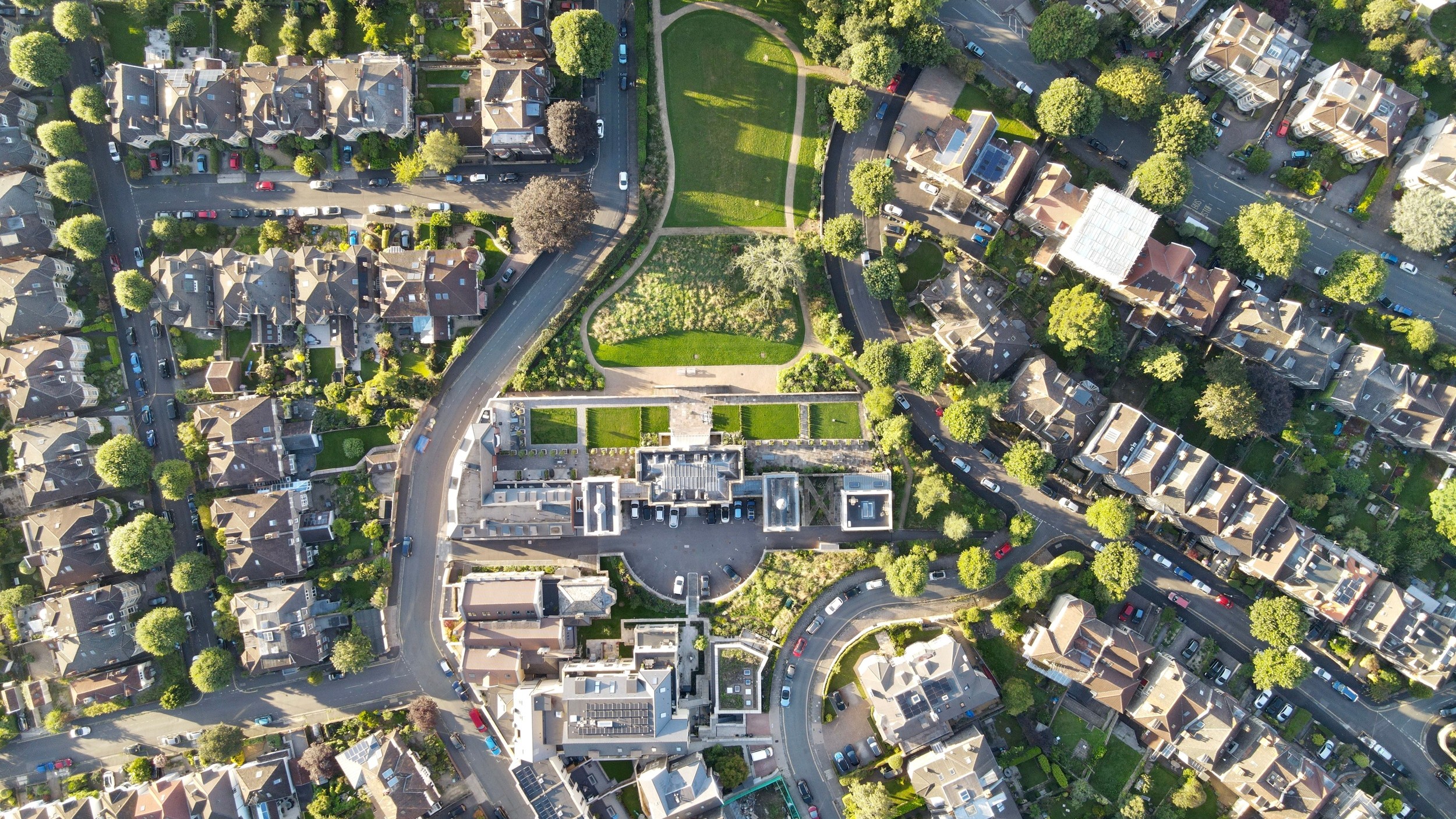
© Elizabeth Otter
Cold, damp, expensive, difficult – the all-too-familiar remarks heard when working on listed buildings. When the conversation turns to sustainability, photovoltaics and heat pumps are often the first and only recommendations – before quickly being dismissed due to concerns about listed building consent or planning restrictions.
However, historic property has an important role to play in achieving carbon neutrality. Sustainability need not be highly invasive or involve expensive retrofitting; indeed, such approaches may not only discourage building owners who cannot afford the high costs but also overlook the sustainability inherent in conservation activities.
The reuse and adaptation of historic buildings represents an embodied carbon saving. Doing so makes them more cost-effective, increases their lifespan and extends their historic narrative, meaning they’re less at risk from being abandoned or suffering from lack of investment.
Preserving, managing and using what already exists is at the heart of the six Rs of sustainability: rethink, refuse, reduce, reuse, recycle and repair. Better maintenance and care of built fabric increases the longevity of materials and building use. This in turn improves performance, promoting reuse rather than demolition.
Climate change intensifies challenges
Climate change is presenting new challenges for old buildings, though, including overheating. Rather than focus exclusively on heating demand when retrofitting, we therefore need to understand that our properties increasingly require cooling to cope with trapped heat in extreme temperatures.
Current weather patterns mean that 55% of UK homes are at risk of overheating, and this figure is only set to increase.
More research on the use of solar shading in the historic built environment is needed, yet there is relatively little consideration of or tolerance for the necessary fixings on the external facades of protected buildings.
Dealing with the wealth of information available on how to make historic buildings more sustainable can be daunting. However, Historic England and the Sustainable Traditional Buildings Alliance are good sources of online guidance.
Hierarchy helps map course of action
So how do have productive conversations with clients about sustainability in historic buildings?
Understanding the sequence of mitigations is important, to ensure we don't recommend abortive works or overlook considerations that limit the efficacy of chosen interventions.
Adapting the hierarchy of controls – which is frequently used by the Health and Safety Executive and National Institute for Occupational Safety and Health – architect and consultancy Purcell has devised its own tool for framing discussions and developing strategy, dubbed the hierarchy of responsible retrofit.
The hierarchy of controls uses five levels through which the engineer works to identify and rank safeguards for those carrying out tasks.
This principle is adapted in the Purcell retrofit tool to support architects and surveyors considering sustainable strategies in historic buildings, and follows five consecutive stages: know, eliminate, mitigate, improve and act. Working through these at the planning stage should help map out the best course of action for an individual building.
Knowing building context is critical
As with a survey, a desktop study is essential at the start because understanding the client's situation will help to outline the feasibility of and requirements for a retrofit. Considerations can include the budget, tenure, use and occupation of the building, as well as the construction make-up.
Heritage context is key, so the focus should be on important aspects of the building that need conservation, as well as upgrades. You should consider the building's condition and management by referring to condition surveys or technical reports.
Geographical context is also vital. For example, the building's orientation can have a significant impact on the risks of certain types of defect, and its inherent energy efficiency.
A contextual understanding of building behaviour and fabric should be the basis of any future recommendations if we are to avoid interventions that may cause irreparable damage to, or loss of, heritage.
If we don't exercise such understanding, then we may reinforce the view that older buildings are an obstacle to sustainability rather than being able to make a vital contribution to it.
Eliminate then mitigate poor performance
Maintenance is critical to a building's performance. As building fabric has a higher thermal conductivity when wet than dry, it is important to identify and prevent water ingress and saturation as well as draughts.
Improving the efficiency of a building by good maintenance will affect the type and scale of intervention discussed at the improvement or action stage in the hierarchy.
For instance, lowering the energy demand will lower the capacity required of any mechanical and electrical equipment. This means more affordable or alternative equipment may be an option. Similarly, the behaviour of those who use the building should be critically appraised to achieve efficiencies.
A series of detailed energy audits found occupants leaving desktop equipment and lights on overnight, as well as poorly thought out climate zoning within buildings, were the main contributors. It noted that, ‘since technology is operated by humans, failure of the human component can fail the whole mission'.
We need to encourage occupants to analyse their use of the building critically before engineered interventions, particularly where heritage is at risk. Once this is done, mitigating avoidable energy and resource use can be quick and easy, and may not even require listed building consent.
This will also lower costs, making it more feasible for owners or buildings with little scope for major intervention.
Window coverings to reduce heat loss or gain, low-flow sanitary fittings and LED replacements for light bulbs can all contribute to better energy performance and a more comfortable building.
‘We need to encourage occupants to analyse their use of the building critically before engineered interventions, particularly where heritage is at risk'
Improvement and action informed by earlier stages
The exciting part comes after all the options have been thoroughly explored at the previous stages, when it is finally time to consider potential improvements to the building.
Understanding the building's construction type and style will ensure that such interventions do not cause new problems. Having considered heritage context and building defects at the initial knowledge stage, you will have identified appropriate upgrades and interventions with the best chances of success.
Provided you have followed the four earlier stages, your selection and implementation of low- and zero-carbon technologies will be holistic, appropriate and proportionate, and you can now act on your understanding.
Bear in mind that installing such technologies can be highly invasive and listed building consent is likely to be required. However, by working through the previous stages you should be able to demonstrate to the relevant authorities that your intervention has been carefully considered.
The adaptation of Ledston Hall in West Yorkshire, for example, shows how to improve the thermal performance of an historic building by successfully working through these stages.
Maintenance has place in mitigation
The climate crisis is a global challenge and our buildings must not only respond to this but be part of the solution, as well as testament to future generations of our fight to adapt.
Retrofit does not mean the same approach needs to be taken in every case; neither is it an all-or-nothing approach. A historic building that cannot be given a major or deep retrofit is not without merit. There are still advantages to good maintenance that eliminates or mitigates inefficiencies.
Mitigating the climate impact of historic buildings will be a collective effort involving different interventions. Our heritage deserves to be a part of the future built environment – and every building can do something to contribute.
RICS members role in retrofitting heritage buildings
Steve Lees, RICS' residential survey senior speclalist, says: 'RICS members with suitable competence and skills have a vital role to play in the process of retrofitting and ensuring that heritage buildings are carefully considered by working closely with building owners to deliver successful, suitable and sustainable projects.
'These activities are also supported by our RICS Residential retrofit standard, Retrofitting, improving the energy efficiency of your home and Domestic air source heat pumps consumer guides.'
Elizabeth Otter MRICS is a chartered building surveyor with expertise in the historic environment
Contact Elizabeth: Email
Related competencies include: Building pathology, Conservation and restoration, Sustainability
RICS Building Surveying Conference
13 May | 09:30 – 17:00 BST | London
This year the conference addresses the most pressing challenges in the built environment from regulatory shifts to sustainable practice, technical insight, and digital transformation.
Featuring tailored breakout sessions, key topics covered include:
- Fire safety compliance and the Grenfell Tower Inquiry Phase 2 Report.
- Climate resilience and sustainable building strategies.
- Managing building defects and technical due diligence.
- Adaptive reuse, BREEAM refurbishment, and retrofitting for longevity.
- Navigating neighbourly matters and social equity in buildings.
- Artificial intelligence and the evolving role of the surveyor.


